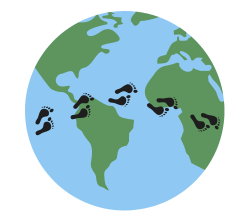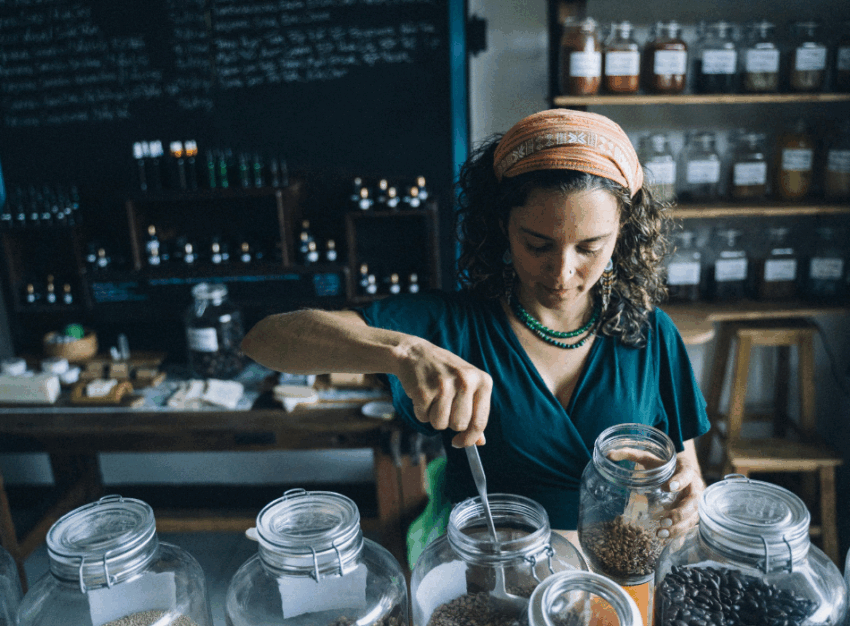Bulk shopping has been an aspect of living a sustainable lifestyle that I’ve mostly avoided. I can come up with various excuses, such as that I don’t have many appropriate containers or that it’s awkward to carry glass jars when grocery shopping without a car.
But we know that plastic waste from food packaging is a major problem. So here are tips for bulk shopping that we can all try!
The benefits of bulk shopping
Bulk shopping has many benefits for the planet and your wallet! Shopping in bulk reduces packaging waste, particularly if you use reusable containers. Ingredients often have a cheaper price per unit. You can also buy the exact quantity you want, preventing food waste and allowing you to try a small amount of an ingredient before committing. In this way, bulk shopping exposes you to products and ingredients that you may not try otherwise.
How to shop in bulk
The process for shopping in bulk varies from store to store, but these are the general steps to follow. If you’re unsure about how things work at a specific store, just ask the staff!
1. Get your containers weighed
Most stores will weigh your containers before you fill them, either at the cash or a weighing station. The tare is the container’s weight when it’s empty. This amount will be subtracted from the final weight so you don’t pay for the weight of your container!
2. Fill your containers
Generally, you will wander around the store and fill your containers yourself, choosing which ingredients to get and in what quantity. At some stores, you instead tell the clerk behind the counter which ingredients you would like.
3. Write down the product code (optional)
At some stores, you are expected to write down the code for your chosen ingredients. In other cases, you may print a label or just tell the clerk the ingredients’ names.
4. Pay for your purchases
The clerk will then weigh your containers, subtracting the tare, and add up the total based on the unit price for the ingredients. Once you have paid for your purchases, you are good to go!
Tips for bulk shopping
Here are a few more tips to help you make the most of your bulk shopping trip!
Know where to shop in bulk
Though you may immediately think of finding a bulk or zero waste store, there may also be other stores near you that offer bulk shopping! For example, many health food stores and some grocery stores have a bulk food section. If you’re not sure where to go bulk shopping near you, try a quick Google search or asking in a local zero waste Facebook group.
Know what to buy in bulk
Bulk food stores are known for their dried goods like legumes, pasta, rice, flour, nuts and seeds, and herbs and spices. Many stores also have liquid household products like shampoo and conditioner, soap and laundry detergent. Before going for your first bulk shopping expedition, it may be worth doing a research trip to see what types of products are available.
Bring a shopping list
You may get overwhelmed by the variety of ingredients that are available. Bringing a shopping list will help you stay focused, so that you don’t buy a bunch of ingredients that you won’t actually use! For help writing a shopping list, check out my post on meal planning.
Know what type of containers to bring
The best type of container to bring will depend on what you are planning to buy. Above all, make sure the containers are clean and dry. Some containers you might want to consider are glass jars, reusable containers, and cloth or mesh produce bags. You can also hang on to containers like yogurt tubs, peanut butter jars and coffee tins. If nothing else, the store may have paper bags, which are slightly better than single-use plastic bags.
Get used to shopping by weight
Ingredients at bulk food stores are typically priced by weight. For example, the tag may state the price per 100 grams or kilogram. Though an ingredient may sound expensive per kilogram, if you only buy a bit, the price won’t be too high. On the other hand, some ingredients may end up more expensive than you were expecting. It will likely take a few times shopping in bulk to get used to the pricing system!
My commitments for bulk shopping
As I mentioned at the start of this post, bulk shopping isn’t something I’ve done a lot of yet. Here are some steps I plan to take to start shopping in bulk:
- Hang on to containers that could be used for bulk shopping
- Familiarize myself with the bulk section at my local health food store
- Before buying an ingredient at the grocery store, stop to think whether it could be bought in bulk
Bulk shopping tips for a healthy planet
Shopping in bulk using reusable containers is one way to reduce the plastic waste associated with grocery shopping. Try some of these tips to get started on your bulk shopping journey!
I want to know: Do you shop in bulk regularly? Do you have any tips for those just getting started?
Categories and tags:
Share this post:

